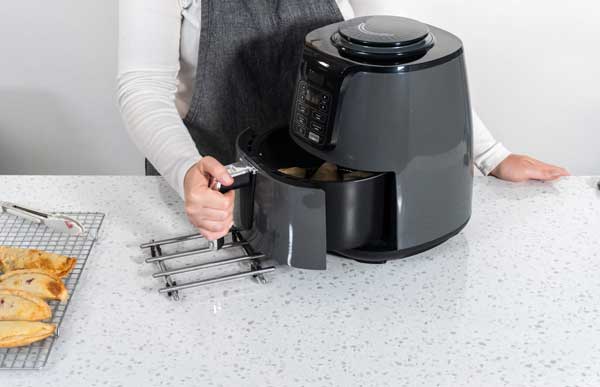Air fryers have exploded in popularity over the last decade, with sales growing rapidly as home cooks seek out lower-fat alternatives to deep frying. Air fryer manufacturers tout up to 90% less fat compared to deep frying, making air fryers seem like a guilt-free way to enjoy crispy fried favorites. But how much healthier is air fried food really? Are there any downsides to this cooking method?
In this article, we’ll investigate the technology behind air frying, its potential health benefits over deep frying, and the challenges that may prevent widespread adoption among hawker stalls and restaurants in Singapore. With the help of a food scientist and lab test results, we’ll uncover just how much of a healthier cooking revolution air fryers truly represent.

How Air Fryers Work
Air fryers rapidly circulate extremely hot air around food to produce a crispy, fried texture. But how is this different from simply baking food in a conventional oven? To understand the technology, I spoke with food scientist Joe Wei Biao.
“Air frying relies on circulating very hot air, usually around 200°C, to quickly cook and crisp up the food’s outer surface,” Joe explained. “Whereas deep frying cooks food by submerging it in hot oil, the air in an air fryer cooks via convection.”
While ovens also use hot air, air fryers differ with a much more powerful fan that rapidly circulates the air around food. This allows air fryers to mimic the quick browning and textural qualities of deep frying. Adding a small amount of oil to foods can enhance this even further.
Potential Health Benefits of Air Frying
By requiring little to no oil, air fryers significantly reduce the fat and calories in typically fried foods. But how do the nutrition profiles actually compare? To find out, I had samples of air fried and deep fried chicken, fish, and potatoes tested at an international food lab.
The results showed air fried chicken contained 38% less saturated fat and 55% less trans fat versus the deep fried version. For fish, saturated fat declined by 53%. Trans fats remained negligible in both.
Air fried potatoes saw a 53% reduction in saturated fat compared to deep fried french fries. As plant foods, potatoes have no cholesterol naturally.
“These are really positive findings,” says nutritionist Carolyn Stephen. “The significant reductions in saturated and trans fats should improve heart health.”
The Downside of Acrylamide
While air fryers scored wins for cutting fat, one result raised alarm bells – acrylamide. This potentially carcinogenic compound forms when starchy foods are cooked at high temperatures above 120°C, whether baked, fried, or air fried.
My test found acrylamide levels in air fried potatoes soared to 1400 micrograms/kg, versus less than 10 micrograms/kg in deep fried. But nutritionist Carolyn cautions there’s no proven safe limit.
“The jury is still out whether acrylamide levels in food pose a real health risk,” she says. “We lack evidence from human studies.”
I consulted air fryer expert Nicholas Lee, who recommends staying under 180°C and avoiding overcooking to minimize acrylamide production. Soaking potatoes before air frying also helps.
The Promise and Pitfalls for Hawker Stalls
My lab results convinced me of the potential health gains of air frying at home. But what about at hawker centres, where deep frying still dominates?
To test feasibility, I teamed up with a popular western food stall to trial air fried options. We served cajun wings, cajun rings, and roasted wing steaks cooked in 3 large air fryers. Customers found the food tasty and appreciated the lower oil.
But stall owner Chu Kong Chi says fully switching remains impractical. The small batches air fryers handle are too slow for hawker stall lunch rushes. Fryers also occupy valuable space. Most customers still prefer the taste of deep fried, he notes.
Industrial air fryers could potentially overcome these hurdles in future. But for now, air frying at hawker stalls faces an uphill battle.
Conclusion:
My investigation shows air fryers live up to their promise of serving up less fatty, calorie-laden versions of traditionally fried foods. For home cooks, they present an appealing way to cut fat without sacrificing taste. Watching cooking times and temperatures can help minimize any acrylamide concerns.
For hawker stalls, air frying isn’t yet feasible for full scale implementation. But manufacturers continue working on larger, more powerful commercial models. And with Singaporeans willing to pay more for healthy food options, air fryers may slowly find their niche in hawker centres over time.
For now, I’m happy air frying my favorite indulgences at home. But I’ll be eagerly awaiting the day I can also enjoy air fried chicken wings at the hawker centre while keeping my guilt at bay.
